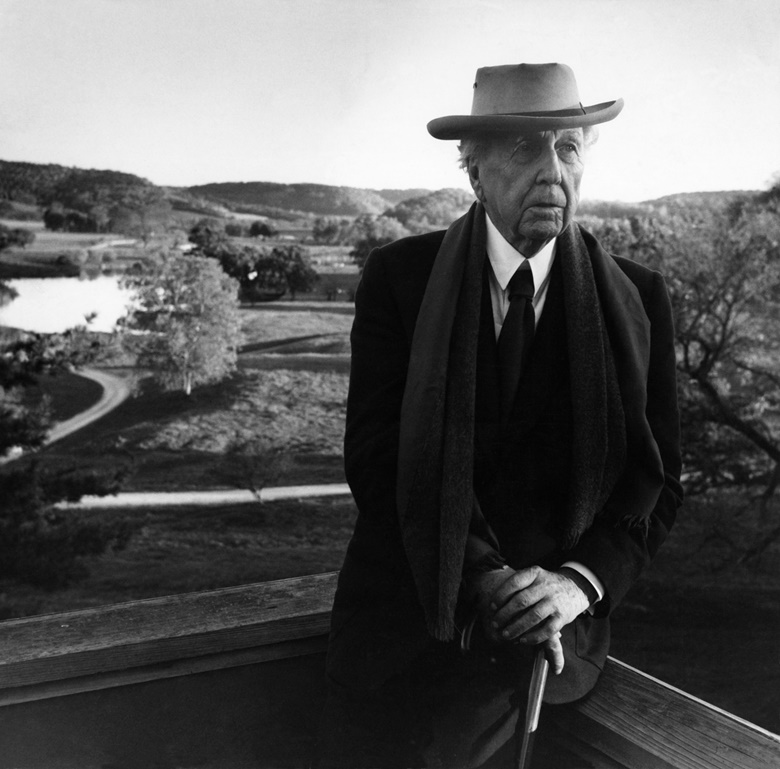
Frank Lloyd Wright: a collector’s guide
Placing immense value on a project’s landscape and interior furnishings, the architect conceived buildings as total works of art
From his high Prairie period at the turn of the century to his final iconic commissions during the 1950s, ‘Frank Lloyd Wright’s impact on architectural history is immeasurable,’ says Michael Jefferson, Christie’s 20th Century Design Specialist. ‘He is considered the greatest architect of all time.’
Originally part of the Chicago School of Architecture, revered for its ‘Commercial Style,’ Wright worked for Louis Sullivan, often called a ‘father of skyscrapers’. Though as he increasingly received high-budget commissions throughout the 1900s, the Wisconsin-born talent grew independent of prevailing movements, developing his own signatures in the process.
Broadly called ‘organic design,’ Wright’s radical approach to architecture entailed creating buildings that were in harmony with their environments, The goal was for a structure to look as if it had grown there through natural processes. ‘While there were many architects and artists before Wright that were inspired by nature, he distilled it to its purest geometries and structures,’ adds Jefferson.
Wright’s buildings had an unconventional flow as well. ‘Before him, you would have a church where everything was symmetrical. There would be big doors at the front, and you would walk straight in,’ notes Jefferson. ‘With Wright, you will have a meandering path to access a building. There’s a journey from the outside world into the inside world. As you enter, the ceiling is compressed before opening again. That transformative process was a radical notion.’

Frank Lloyd Wright, Madison, Wisconsin. Photograph by Science History Images / Alamy Stock Photo
Other key aspects of Wright’s exterior designs include long cantilevered roof lines and ‘ribbons’ of windows. Wright would also often use Roman brick, a long horizontal brick that he would stack in rows. Masons would have two types of mortar: dark mortar that was the same colour as the brick for the vertical seam and a lighter inset mortar for the horizontal lines between each row. This created an effect of extending the horizontality and situating the structure in the landscape.
Inside, most of Wright’s furniture was bespoke for commissions built from the ground up. ‘He was not resting on his principles — each time he designed something he was adapting to the space and to the constraints of the project and building itself,’ says Jefferson. ‘There’s a lot of variations on a theme for a specific structure.’
Wright’s furniture design influenced modernism and future movements, as illustrated by the Bauhaus and De Stijl. Because of Wright, the building environment of the 20th century was forever changed. Here, Christie’s revisits some of Frank Lloyd Wright’s most significant architectural feats, including the residential commissions that have come to define his success.
Ward W. Willits House, Highland Park, Illinois (1901)
In the final years of the 19th century, Wright’s principles of geometric and organic design culminated in a masterpiece of Prairie style, the Ward W. Willits house. Situated on a lot in Highland Park, Illinois, the Willits house, with its cruciform plan that pushed away from the central core of the house, accentuated the horizontal. Decorative line work was applied to the exterior, and long, unified eaves overhang the bands of ribbon windows set with simplified geometric panes of art glass.
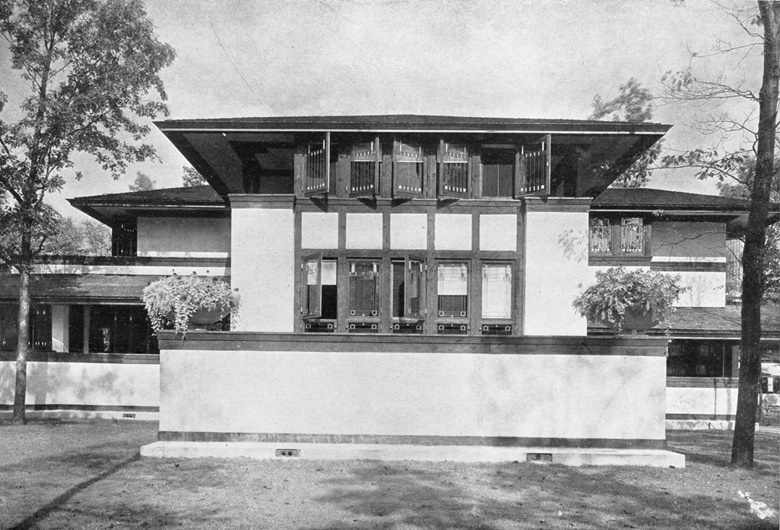
Ward W. Willits House, Highland Park, Illinois. Photograph by Chicago Architectural Photography Company/Frank Lloyd Wright Preservation Trust/Getty Images. Artwork © 2022 Frank Lloyd Wright Foundation. All Rights Reserved. Licensed by Artists Rights Society
Within the space, Wright created a dining room suite with chairs whose linear geometry were a revolution in chair design and was a catalyst for change in architecture and the arts. They feature a solid trapezoidal seat frame which have no taper to the front legs. The highly vertical backrest is framed by rear legs that taper gently as they reaches its lofty apex at the top.
.jpg?mode=max?w=780)
Frank Lloyd Wright (1867-1959), two important chairs from the Ward W. Willits House, Highland Park, Illinois, executed by John W. Ayers, Co., c. 1902. Sold for $325,000 in Design on 13 December 2019 at Christies in New York. Artwork © 2022 Frank Lloyd Wright Foundation. All Rights Reserved. Licensed by Artists Rights Society
The chairs of the Willits dining room suite had remained in the Willits house from 1902 until the family’s passing in the early 1950s, when the house and its contents were sold to a new owner. Other examples of Willits chairs eventually found their way into museums including the Metropolitan Museum of Art in New York, the Victoria and Albert Museum in London and the Los Angeles County Museum of Art.
Francis W. Little House, Peoria, Illinois (1903)
The Francis W. Little House represents one of Wright’s earliest Prairie Style projects. Due to its robust budget, the house contained some of the architect’s most innovative and elaborate lighting, chairs and window designs. A particularly radical concept was Wright’s dining room, where the verticality of the chairs intentionally juxtaposed the home’s overall horizontality.
‘The chairs would tower over people’s back, and this kind of verticality would create a mini environment, a room-within-a-room effect,’ says Jefferson of the unique high-back chairs, which each had a different height. ‘There are purely geometric planes of wood that construct this chair, but the power is in the details. They can be seen as geometric sculptures that function as furniture.’
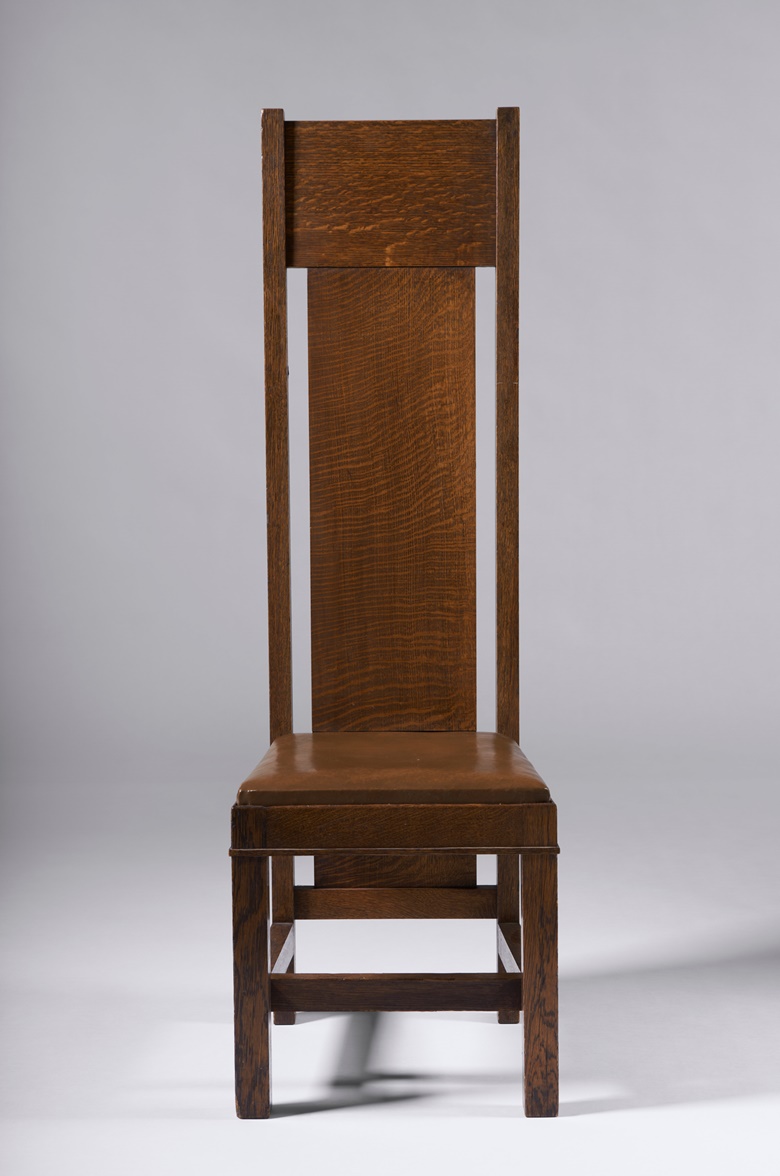
Frank Lloyd Wright (1867-1959), high-back side chair, for the Francis W. Little House, Peoria, Illinois, c. 1902. Estimate: $120,000-180,000. Offered in Design on 9 December at Christie’s in New York
After their Peoria home, the Littles commissioned a second house in Wayzata, Minnesota. The living room from that residence is now housed at the Metropolitan Museum of Art in the American Wing’s period rooms. While the Francis W. Little House in Illinois still stands, the interior has since been dismantled and refurbished.
Dana-Thomas House, Springfield, Illinois (1902–1904)
The Dana-Thomas House was designed for Susan Lawrence Dana, an American philanthropist and heiress, and represents, according to Jefferson, ‘the ultimate no-budget-constraints project’. The residence, which has 35 rooms and 12,000 square feet of living space, has been fully restored as a museum and features the largest collection of site-specific, original Wright art glass and furniture.
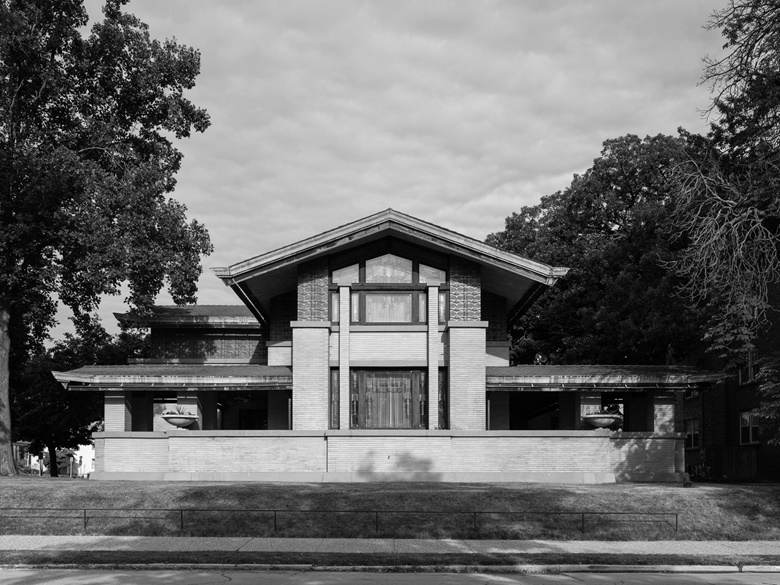
Dana-Thomas House, Springfield, Illinois. Photograph: Serhii Chrucky / Alamy Stock Photo. Artwork © 2022 Frank Lloyd Wright Foundation. All Rights Reserved. Licensed by Artists Rights Society
Two of the most memorable Wright objects sold at Christie’s come from this home. In May 2021, a monumental, glazed earthenware vase estimated between $30,000-50,000, realised $362,500. The piece was produced by the American Terracotta Tile and Ceramic Company (Teco), which was founded in 1881 and became America’s first manufactory of architectural terracotta. The company was known for its matte, minty ‘Teco Green’ glaze.
.jpg?mode=max?w=780)
Frank Lloyd Wright (1867-1959), an important leaded glass and bronze table lamp, exectued by the Linden Glass Company for the Susan Lawrence Dana House, Springfield, Illinois, c. 1903. Sold for $1,989,500 in Important 20th Century Decorative Arts and Tiffany on 10 December 2002 at Christie’s in New York. Artwork © 2022 Frank Lloyd Wright Foundation. All Rights Reserved. Licensed by Artists Rights Society
In December 2002, a leaded glass and bronze table lamp executed by the Linden Glass Company sold for nearly $2 million. At the lamp’s creation in 1903, Susan Lawrence Dana’s house was one of the first homes in Springfield to make use of electric lighting, and this lamp — one of two double pedestal lamps in the home — is believed to have originally been situated in the library. In 1988, Christie’s arranged a private sale of the mate to this lamp back to the Dana-Thomas House.
Meyer May House, Grand Rapids, Michigan (1908–1909)
Another high-budget commission was the Meyer May House, the only Prairie Period house in Michigan. Commissioned for a prominent Grand Rapids clothier, the home was purchased by Steelcase Inc. (a leading manufacturer of furniture for offices, hospitals, and classrooms) in 1985, and meticulously restored and opened to the public in 1987.
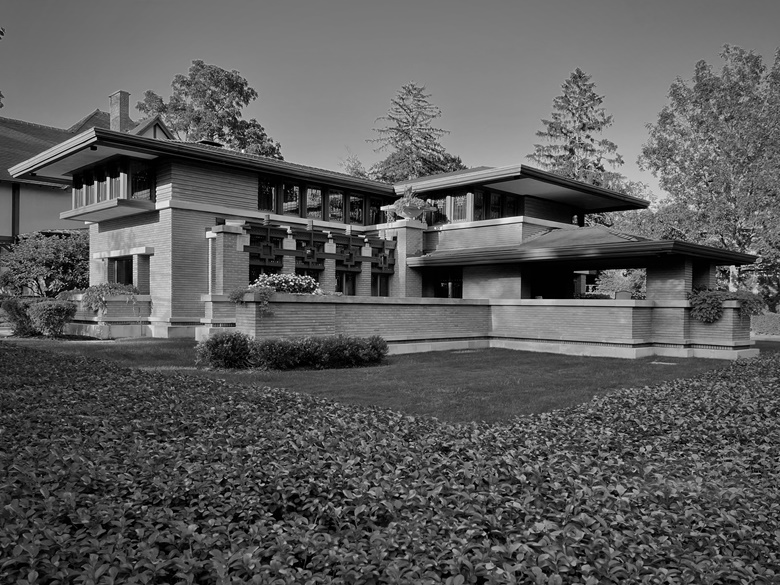
Meyer May House, Grand Rapids, Michigan. Artwork © 2022 Frank Lloyd Wright Foundation. All Rights Reserved. Licensed by Artists Rights Society
Christie’s December 2022 sale of windows and drawings from this home represents the first time any work from the property has come to market. ‘With bespoke interiors and beautiful windows, this home was truly a complete work of art,’ says Jefferson. The numerous drawings and detailed renderings on offer illustrate the process of creating the home’s rugs, tables, and more.
The stained-glass windows depict a clever simplification of trees and foliage, while inviting nature itself into the home. Jefferson additionally notes Wright’s ingenious, artful application of glass in other parts of the home: ‘In Meyer May, Wright utilised glass that is shimmering and reflective along the horizontal mortar lines of the brick for the hearth, which is the beating heart of the house.
Avery Coonley House, Riverside, Illinois (1908–1912)
The Avery Coonley House is one of Wright’s most iconic Prairie Period residences, and many of the architect’s most famous stained-glass windows and furniture have come from it — numerous examples of which are in esteemed museum collections. Originally a single-family residence, the house has since been altered into several distinct residences, but many of the original details are still intact.
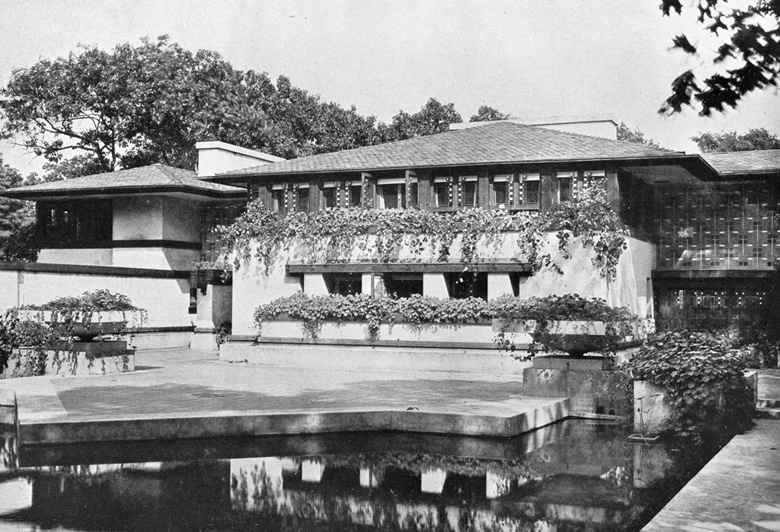
Avery Coonley House, Riverside, Illinois. Photograph by Chicago Architectural Photography Company/Frank Lloyd Wright Preservation Trust/Getty Images. Artwork © 2022 Frank Lloyd Wright Foundation. All Rights Reserved. Licensed by Artists Rights Society
Barbra Streisand later acquired a three-tiered flower table created for this home. ‘It embodies so much of Wright’s architectural practice and thinking in one piece of furniture that it actually reads as a piece portable architecture,’ says Jefferson, calling attention to the work’s cantilevered shelves, which mirror the rooflines of the home. ‘It’s not just static pure geometry. It has such life to it, which makes it quite covetable.’
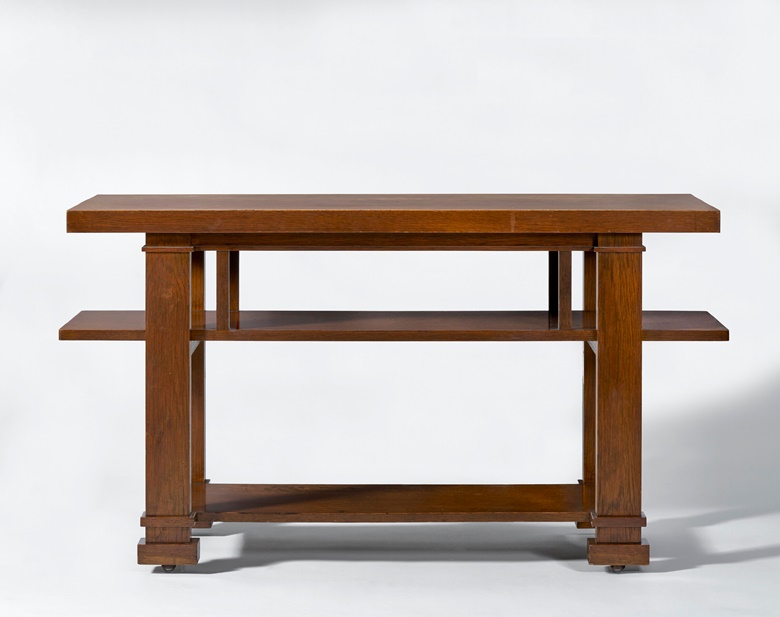
Frank Lloyd Wright (1867-1959) and George Mann Niedecken (1878-1945), three-tier ‘flower table’, for the living room of the Avery Coonley House, Riverside, Illinois, c. 1908. Estimate: $150,000-250,000. Offered in Design on 9 December at Christie’s in New York
A few blocks from the Coonleys’ residence, Wright created a small playhouse that could serve as a school for the couple to educate local children. The Avery Coonley Playhouse’s 40 plus windows are widely considered Wright’s masterpiece in glass. With their buoyant circles, they created a continuous whimsical pattern around the buildings main room. For the bright red, green, blue, orange and black glass windows — colours he had not used before — Wright was inspired by a passing parade, complete with confetti, balloons and American flags.
Fallingwater, Bear Run, Pennsylvania (1935)
As Wright’s architecture developed during the 1920s — largely in California — the Great Depression struck. The architect’s personal reputation also began to suffer during this time due to affairs and other controversies, resulting in the loss of several commissions. His moment of architectural redemption came in 1935 when the prominent Pittsburgh Kaufmann family, whose patriarch Edgar Jones owned Kaufmann’s Department Store, commissioned what would become Wright’s most iconic building.
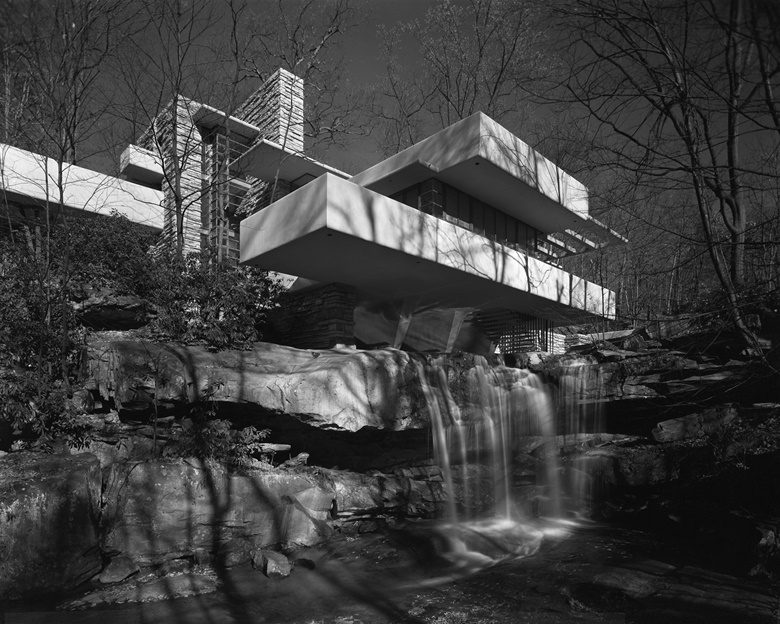
Fallingwater, Bear Run, Pennsylvania. Photograph by Hedrich Blessing Collection/Chicago History Museum/Getty Images. Artwork © 2022 Frank Lloyd Wright Foundation. All Rights Reserved. Licensed by Artists Rights Society
While the family’s son, Edgar jr, was participating in an apprenticeship at the Taliesin Fellowship, a communal architecture program established by Wright and his wife in 1932, the Kaufmanns met with the famed architect. They asked him to design a weekend house for their family along Bear Run in southwestern Pennsylvania’s Laurel Highlands, and Fallingwater was born.
‘Wright applied principles that he had developed early on in his career — cantilevering and building a house that is perfectly sited and suited to its environment,’ notes Jefferson. ‘The marvellous house seated on top of a waterfall was a revelation.’ Fallingwater’s immediate success led to important commissions, including the Solomon R. Guggenheim Museum in New York in the late 1950s.
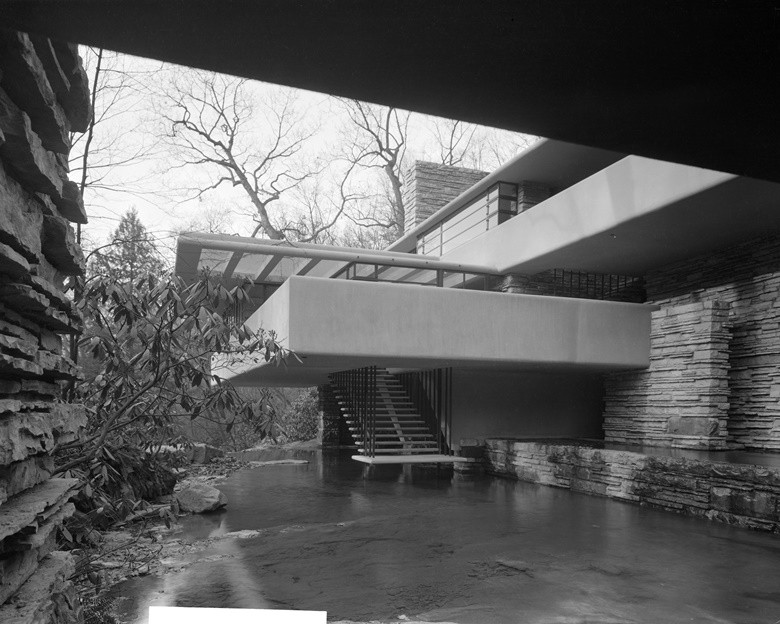
Fallingwater, Bear Run, Pennsylvania. Photograph by Hedrich Blessing Collection/Chicago History Museum/Getty Images. Artwork © 2022 Frank Lloyd Wright Foundation. All Rights Reserved. Licensed by Artists Rights Society
After inheriting Fallingwater upon his father’s death in 1955, Edgar jr, who worked at the Museum of Modern Art, New York for 15 years and established himself as a leading authority on Wright’s architecture, entrusted the property and its some 1,500 acres of land to the Western Pennsylvania Conservancy as a tribute to his parents.
S.C. Johnson Wax Headquarters, Racine, Wisconsin (1936–1939)
When it came to creating a truly modern administrative office for S.C. Johnson (a privately held manufacturer of household cleaning supplies and other consumer chemicals), third-generation leader H.F. Johnson, Jr. set his eye on Frank Lloyd Wright. As stated on the company’s website, Johnson proclaimed: ‘Anybody can build a typical building. I wanted to build the best office building in the world, and the only way to do that was to get the greatest architect in the world.’
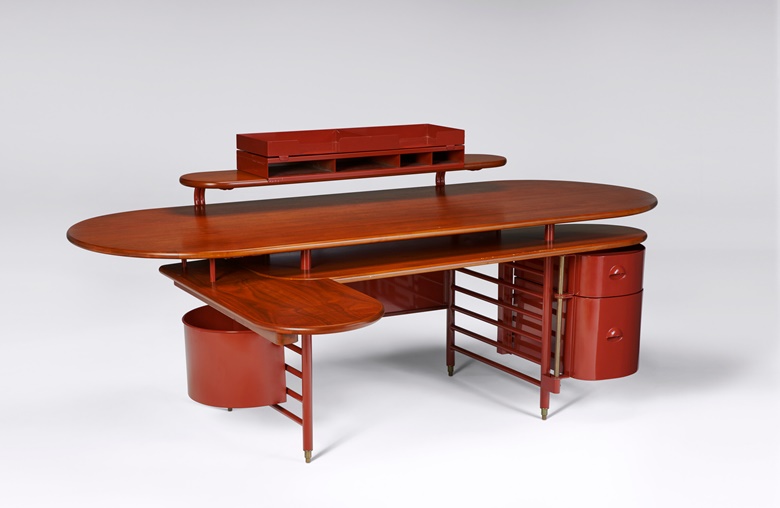
Frank Lloyd Wright (1867-1959), executive desk master for S.C. Johnson Administration Building, Racine, Wisconsin, c. 1937-1939. Estimate: $400,000-600,000. Offered in Design on 9 December at Christie’s in New York
Indeed, the building, which opened in 1939, stands fully intact today as intended by the architect. ‘The more commercial approach Wright took to the corporate campus redefined open-plan workspaces,’ says Jefferson, emphasising the building’s radical Great Workroom, which epitomises Wright’s strategic balance of form and function. The communal workroom is known for its tree-shaped columns that blossom into circular tops that resemble abstract lily pads.
Because the interior furnishings, based on the master copies, remain in place today, it is incredibly rare that Christie’s is offering this desk and chair used during the development process to create the final products — very few examples of these works are housed in public institutions, such as the Victoria and Albert Museum and the Art Institute of Chicago. Both lots, created by Steelcase Inc., combine wood and painted steel-tube construction, which Wright was incorporating into his furniture design for the first time.
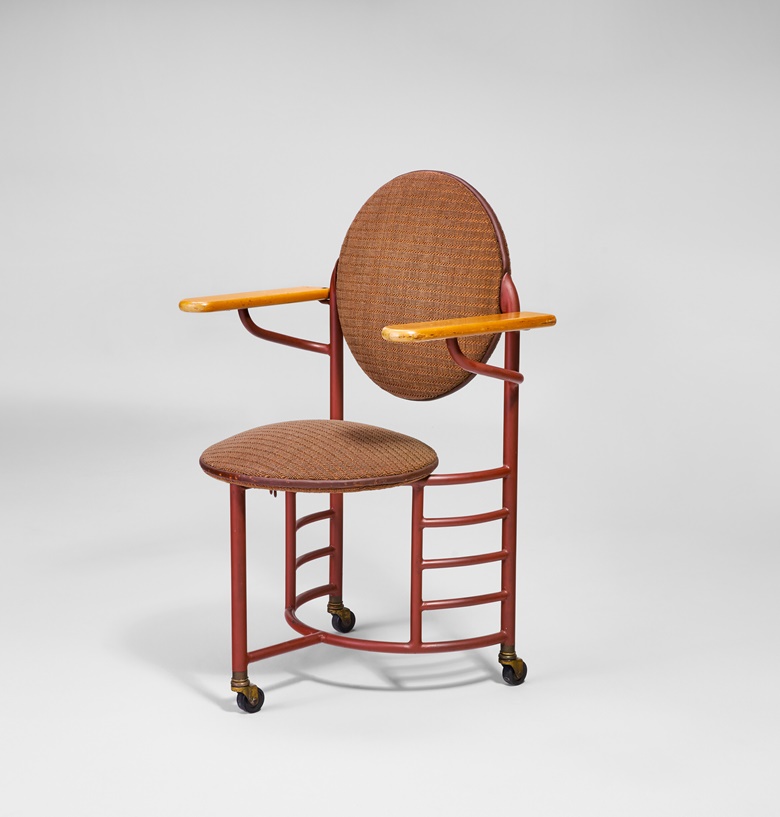
Frank Lloyd Wright (1867-1959), executive armchair master for S.C. Johnson Administration Building, Racine, Wisconsin, c. 1937-1939. Estimate: $70,000-100,000. Offered in Design on 9 December at Christie’s in New York
‘He considered the Great Workroom to be as glorious and uplifting as any cathedral or religious space that has ever existed, yet it’s built for a capitalist society in a corporate office environment,’ says Jefferson. ‘The design was meant to encourage collaboration and efficiencies in the workspace. This open plan and natural light streaming down are still things we implement in current office spaces. It’s a predecessor to today’s dot-com campuses in California and the Northwest.’
Sign up today
Christie’s Online Magazine delivers our best features, videos, and auction news to your inbox every week
Subscribe